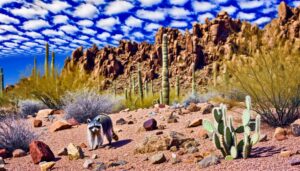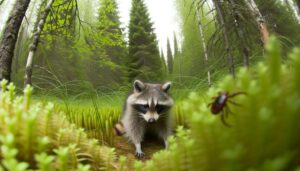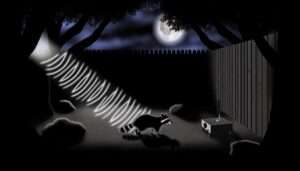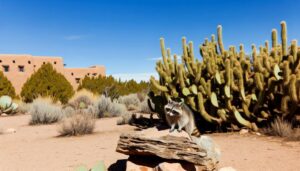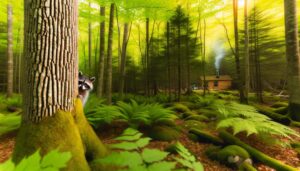How Do Raccoons Get Into City Environments?
Raccoons infiltrate urban environments through their exceptional adaptability and resourcefulness. They exploit diverse urban food sources, such as restaurant trash bins and residential garbage cans, and use a variety of man-made structures for shelter.
Their dexterous forepaws facilitate manipulating objects and opening containers, aiding in food access. Human activities inadvertently enhance raccoon food availability, altering their natural foraging behaviors.
Additionally, raccoons demonstrate seasonal migration patterns and sophisticated strategies to avoid urban predators. Understanding these dynamics reveals more about the symbiotic relationship between urban development and wildlife adaptation processes.
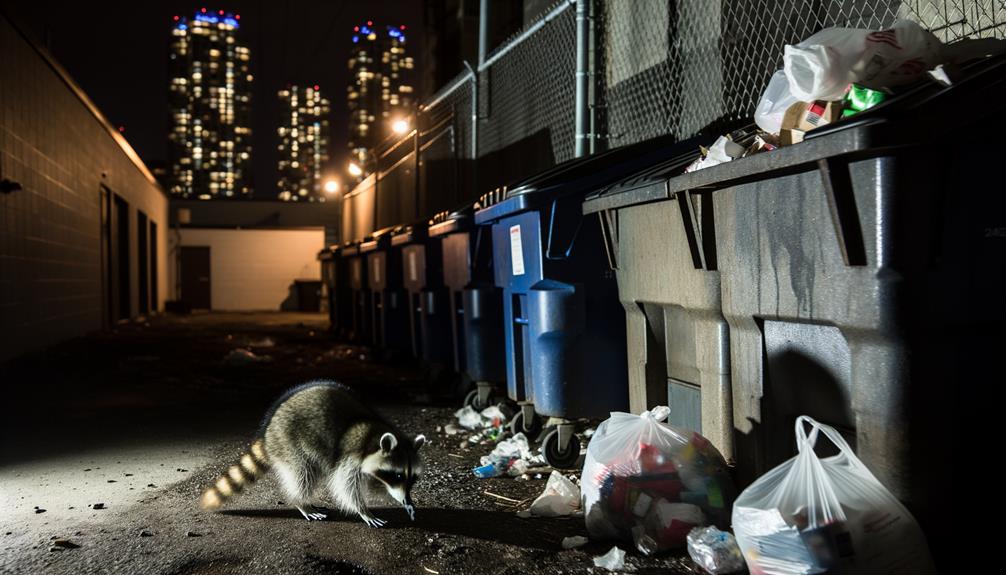
Key Takeaways
- Raccoons are drawn to cities by abundant food waste and easy access to nutrient-rich resources.
- Urban development provides numerous man-made structures for shelter, attracting raccoons.
- Raccoons use their dexterous forepaws to manipulate and access food sources in urban environments.
- Increased human activity and waste management practices create favorable conditions for raccoons.
- Urban areas offer a variety of safe den sites, protecting raccoons from predators and harsh weather.
Urban Habitat Adaptation
Raccoons exhibit remarkable adaptability to urban habitats by exploiting diverse food sources and utilizing various man-made structures for shelter. Their dexterous forepaws enable them to manipulate objects and access confined spaces, allowing them to thrive in anthropogenic environments.
Observations indicate that raccoons frequently occupy attics, crawl spaces, and abandoned buildings, benefiting from the thermal insulation and protection these structures provide. Urban ecologists have noted that raccoons' ability to adapt extends to their nocturnal activity patterns, reducing human-wildlife conflicts by foraging primarily at night.
This behavioral plasticity underscores their success in urban landscapes, where they navigate a mosaic of natural and artificial features. Consequently, raccoons have become a ubiquitous presence in cities, demonstrating their resilience and ecological versatility.
Food Sources in Cities
Urban environments offer raccoons a wide range of food sources due to human activities. These include restaurant trash bins, residential garbage cans, and public park litter, all of which provide easily accessible and nutrient-rich options. The availability of these anthropogenic food resources plays a crucial role in shaping raccoon foraging behavior and urban population dynamics.
Urban areas serve as convenient habitats for raccoons due to the abundance of food sources generated by human activities. Key points of interest for these animals are restaurant trash bins, residential garbage cans, and public park litter. These resources offer raccoons easily accessible and nutrient-rich food options, significantly influencing their foraging behavior and the overall population dynamics in urban settings.
Restaurant Trash Bins
The abundance of food waste in restaurant trash bins provides a substantial and consistent food source for raccoons in urban environments. These nocturnal foragers have adapted to the urban ecosystem, exploiting the predictable availability of discarded food.
Studies in urban ecology reveal that raccoons exhibit remarkable problem-solving abilities, enabling them to bypass various containment measures designed to secure trash bins. This accessibility to high-caloric intake supports larger populations and enhanced reproductive success.
Additionally, the predictable presence of restaurant waste fosters habitual foraging routes and territorial behaviors. For those committed to urban stewardship, understanding these interactions underscores the importance of secure waste management practices to mitigate wildlife intrusion and promote healthier urban ecosystems.
Residential Garbage Cans
In addition to restaurant trash bins, residential garbage cans also serve as an important food source for raccoons in urban areas. These nocturnal mammals have adapted to city life, utilizing their dexterous paws to access improperly secured garbage bins. The abundance of organic waste provides a reliable and energy-rich diet, contributing to their urban proliferation.
| Observation | Impact | Mitigation Strategies |
|---|---|---|
| Improperly secured lids | Increased raccoon activity | Use raccoon-proof bins |
| Waste spillage | Attracts more wildlife | Regular cleaning and maintenance |
| High organic waste content | Encourages feeding behavior | Composting and waste reduction |
| Nighttime scavenging | Noise and disturbance | Timely waste disposal |
Understanding these dynamics is essential for implementing effective urban wildlife management strategies.
Public Park Litter
Public parks often become significant food sources for raccoons due to the litter left behind by visitors. This litter provides raccoons with easy access to a variety of food types, often contributing to their urban proliferation. Observations indicate that raccoons are particularly attracted to:
- Unattended picnic remnants: Leftover food items from picnics and barbecues.
- Overflowing trash bins: Easily accessible waste when bins are not regularly emptied.
- Discarded food packaging: Containers and wrappers that retain food residues.
- Pet food: Food left out for pets that is not properly monitored.
- Fruit-bearing trees: Fallen fruits from park trees that are not collected.
These food sources highlight the importance of effective waste management and public education to mitigate raccoon presence in urban parks.
Navigating Urban Structures
Raccoons exhibit remarkable adaptability in urban environments by adeptly climbing building exteriors and maneuvering through complex structures. Their physical dexterity allows them to scale walls, access rooftops, and exploit gaps in urban infrastructure.
Additionally, raccoons frequently utilize sewer systems, which provide concealed pathways for movement across the cityscape.
Climbing Building Exteriors
Urban raccoons exhibit remarkable adaptability by skillfully scaling building exteriors, a behavior that underscores their ability to navigate complex urban landscapes. Their dexterous climbing is facilitated by several anatomical and behavioral adaptations:
- Prehensile paws: Enable gripping and manipulating various surfaces.
- Strong hind limbs: Provide the necessary propulsion for vertical ascent.
- Flexible body: Allows maneuvering through tight spaces and around obstacles.
- Keen problem-solving skills: Facilitate the identification of potential climbing routes.
- Sharp claws: Offer traction on diverse materials, from brick to metal.
These traits, combined with their inquisitive nature, make raccoons proficient urban explorers. Their ability to climb buildings not only aids in foraging but also in evading predators, highlighting their ingenuity in urban ecology.
Understanding these behaviors helps in implementing humane urban wildlife management strategies.
Utilizing Sewer Systems
Exploring the convoluted infrastructure of sewer systems, raccoons demonstrate exceptional spatial awareness and adaptability in urban environments. Their ability to navigate these subterranean labyrinths stems from acute sensory perception and dexterous forelimbs, enabling them to traverse confined spaces with ease.
Urban ecologists have observed that raccoons utilize these underground networks not merely as transit routes but also as shelters and sources of food. The dark, often moist conditions of sewer systems provide a refuge from predators and harsh weather. Additionally, these environments offer access to discarded human food, enhancing their survival and proliferation in cities.
Understanding raccoons' use of sewer systems underscores the need for urban planning that considers wildlife movement and coexistence within metropolitan frameworks.
Breeding in Urban Areas
In urban areas, the adaptability of Procyon lotor to diverse environments facilitates their breeding success amidst city landscapes. These nocturnal mammals exhibit remarkable plasticity in nesting site selection and resource utilization, which enhances their reproductive rates within metropolitan settings.
Key factors contributing to their breeding success include:
- Abundant food sources: Urban areas provide ample foraging opportunities from refuse and residential gardens.
- Shelter availability: Man-made structures such as attics, basements, and abandoned buildings serve as ideal denning sites.
- Reduced predation: Lower presence of natural predators in cities offers safer breeding conditions.
- Adaptability to human presence: Raccoons show high tolerance and can thrive despite close proximity to humans.
- Extended breeding seasons: Milder urban microclimates can result in longer reproductive periods.
These characteristics underscore the raccoon's ability to flourish in urban habitats.
Human Interaction Impact
The high adaptability of raccoons to urban environments not only influences their breeding success but also greatly shapes their interactions with human populations. Human activities, such as improper waste management and the availability of anthropogenic food sources, have created conducive conditions for raccoon foraging and habitat establishment. This interaction is bidirectional; raccoons exploit urban resources while humans often respond by modifying their behavior or infrastructure to mitigate conflicts. Below is a summary of key human-raccoon interaction facets:
| Interaction Type | Impact on Raccoons |
|---|---|
| Waste Management Practices | Increased food availability |
| Urban Development | Creation of new shelter opportunities |
| Public Feeding | Altered natural foraging behaviors |
| Wildlife Control Measures | Population and movement regulation |
Understanding these dynamics is essential for fostering harmonious coexistence.
Seasonal Migration Patterns
Urban raccoons exhibit distinct seasonal migration patterns that reflect their adaptive responses to environmental changes and resource availability. These patterns are critical for their survival in urban environments, showcasing remarkable behavioral flexibility. Observations have indicated:
- Spring: Increased movement as raccoons seek food and establish territories.
- Summer: Stabilized home ranges due to abundant food sources.
- Fall: Heightened foraging to build fat reserves for winter.
- Winter: Reduced activity and smaller ranges due to limited resources.
- Breeding Season: Increased male movement to find mates, while females seek secure sites.
These behaviors highlight raccoons' ability to navigate and exploit urban ecosystems effectively. Understanding these patterns is essential for urban wildlife management strategies aimed at mitigating human-wildlife conflicts.
Shelter and Den Sites
Raccoons in metropolitan areas display a preference for diverse shelter and den sites, utilizing both natural and anthropogenic structures to guarantee safety and resource access. They often seek refuge in tree hollows, dense vegetation, and abandoned burrows, but urban environments offer unique opportunities. Raccoons exploit attics, crawl spaces, and chimneys, adapting to human-altered landscapes with remarkable flexibility.
These locations provide vital protection from predators and harsh weather conditions, ensuring their survival in an urban setting. Additionally, the proximity to food sources such as garbage bins and compost piles further incentivizes their choice of den sites. Understanding these preferences is essential for urban wildlife management, as it informs strategies to mitigate human-raccoon conflicts and promote coexistence within city ecosystems.
Nighttime Activities
In addition to selecting versatile shelter and den sites, raccoons exhibit a range of nocturnal behaviors that are pivotal for their survival in urban environments. These behaviors enable raccoons to exploit urban resources efficiently and adapt to the complexities of city life.
Observational studies highlight several key activities raccoons engage in during nighttime:
- Foraging: Raccoons scavenge for food in garbage bins and compost heaps.
- Exploration: They navigate through urban landscapes, including parks and residential areas.
- Social Interaction: Raccoons communicate and socialize with other raccoons.
- Hydration: They locate and drink from various water sources.
- Problem-Solving: Raccoons demonstrate dexterity in opening containers and accessing food.
Understanding these nocturnal activities allows urban ecologists and city planners to develop strategies to coexist with raccoons while minimizing human-wildlife conflicts.
Avoiding Urban Predators
Roaming the cityscape, raccoons utilize various strategies to evade urban predators, ensuring their survival amidst potential threats. These nocturnal mammals often rely on their acute senses and agility to detect and escape from predators such as domestic dogs and coyotes.
By maneuvering through complex urban environments, raccoons exploit rooftops, storm drains, and dense foliage as safe havens. Additionally, their remarkable problem-solving abilities allow them to outmaneuver threats by accessing elevated or enclosed spaces that predators cannot easily reach.
Urban ecology indicates that raccoons often alter their activity patterns, exhibiting heightened vigilance and adopting more secretive behaviors in predator-rich areas. Such adaptive strategies are essential for their persistence in urban settings, underscoring the intricate balance of urban wildlife coexistence.
Conclusion
Urban raccoons have effectively adapted to city environments by exploiting abundant food sources, finding their way through complex urban structures, and finding shelter in various den sites.
A notable statistic is that urban raccoon populations can be three times denser than their rural counterparts, highlighting their successful urban adaptation.
These animals engage in nighttime activities to avoid human interaction and urban predators, ensuring their survival and proliferation in metropolitan areas.
This adaptation underscores the resilience of raccoons in increasingly urbanized landscapes.

